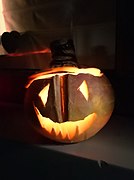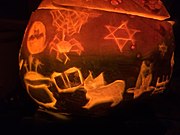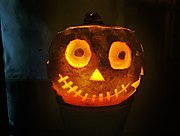Hop-tu-Naa (/ˌhɒp tuː ˈneɪ/ HOP too NAY; Manx: Oie Houney; Irish: Oíche Shamhna [ˌiːçə ˈhəunˠə]) is a Celtic festival celebrated in the Isle of Man on 31 October. It is the celebration of the traditional Gaelic festival of Samhain, the start of winter. It is thought to be the oldest unbroken tradition in the Isle of Man.

Etymology
The Manx name Oie Houney corresponds to the Irish Oíche Shamhna, which was pronounced the same (though not in revived Manx). The exact status of Oíche Shamhna and its role in the Celtic calendar has been a matter of debate. Oíche Shamhna eventually mutated into Halloween in northern England and in Ireland, it was carried to America by Irish immigrants and developed into the modern Halloween.
The term Hop-tu-naa comes from a Manx Gaelic song traditionally sung during the festival which included the nonsense Hop-tu-naa as a refrain; such nonsense rhymes are common theme in Irish and Scottish Gaelic music.
Traditions
On the Isle of Man today, many groups of people continue the tradition of singing Hop-tu-Naa songs "around the houses" (which traditionally referred to waits going around visiting houses, especially those of the wealthy, and soliciting gifts; beggars going "around the houses" are featured in The Deemster) with turnip lanterns. In addition to this, many public Hop-tu-Naa events take place across the Isle of Man each year, most of which today include competitions for artistically carving turnips and the singing of traditional songs. As well as the many events run within local communities, the National Folk Museum at Cregneash hosts an event to teach the traditional Hop-tu-Naa song and to help people to carve turnips.
Turnip lanterns
At the modern Hop-tu-Naa, children dress up and go from house to house hoping to be given sweets or money, as elsewhere. The children carry carved "turnip" lanterns (which are known as "moots" by the Manx) and sing Hop-tu-Naa songs. There are regional varieties of how turnips should be carved for Hop-tu-Naa, with variations focusing on which way up the turnip is and the nature of the decorations. It is believed that turnip-lanterns do not date earlier than the start of the 19th century, as the vegetable had only been introduced at the end of the previous century. In the past children would bring the stumps of turnips with them and batter the doors of those who refused to give them any money, in an ancient form of trick or treat. This practice appears to have died out.
Dancing
A hop-tu-naa dance was collected by both Mona Douglas and Leighton Stowell. It was believed to have been danced through the streets on Hop-tu-Naa night by couples carrying their turnip-lanterns. It is a simple procession dance for pairs of dancers which involves the Manx reel step and a combination of arches only. This dance is taught in many schools on the Isle of Man during October each year, and it is danced at many of the Hop-tu-Naa events across the island.
Divination
Some of the older customs are similar to those now attached to the January New Year. It was a time for prophesying, weather prediction and fortune-telling. Last thing at night, the ashes of a fire were smoothed out on the hearth to receive the imprint of a foot. If, next morning, the track pointed towards the door, someone in the house would die, but if the footprint pointed inward, it indicated a birth.
A cake was made which was called Soddag Valloo or Dumb Cake, because it was made and eaten in silence. Young women and girls all had a hand in baking it on the red embers of the hearth, first helping to mix the ingredients (flour, eggs, eggshells, soot and salt) and kneading the dough. The cake was divided up and eaten in silence and, still without speaking, all who had eaten it went to bed, walking backwards, expecting and hoping to see their future husband in a dream or vision. The future husband was expected to appear in the dream and offer a drink of water.
Other means of divination was to steal a salt herring from a neighbour, roast it over the fire, eat it in silence and retire to bed; or to hold water in your mouth and a pinch of salt in each hand as you listen to a neighbour's conversation, whereupon the first name mentioned would be that of your future spouse.
Traditional foods
Traditional food for Hop-tu-Naa includes mrastyr: potatoes, parsnips and fish mashed up with butter. Any leftovers from this evening meal would be left out with crocks of fresh water for the fairies. Toffee would also be made, with just sugar and water, as a communal activity on the evening of Hop-tu-Naa.
Songs
The Hop-tu-Naa Song
| Hop-tu-Naa (as collected by A. W. Moore) | English translation | Hop! Ta'n Oie (as collected by Dr. John Clague) |
English translation |
|---|---|---|---|
| Shoh shenn oie Houiney; Hop-tu-naa | This is old Sauin night; Hop-tu-naa | Hop! ta'n oie. Noght oie Houney | Hop! ta'n oie. To-night is Hollantide Night. |
| T'an eayst soilshean; Trol-la-laa. | The moon shines bright; Trol-la-laa. | Hop! ta'n oie. Mairagh Laa Houney. | Hop! ta'n oie. To-morrow is Hollantide Day. |
| Kellagh ny kiarkyn; Hop-tu-naa. | Cock of the hens; Hop-tu-naa | Hop! ta'n oie. Kellagh as kiark. | Hop! ta'n oie. Cock and hen. |
| Shibber ny gauin; Trol-la-laa. | Supper of the heifer; Trol-la-laa. | Hop! ta'n oie. Shibbyr y gounee. | Hop! ta'n oie. Supper of the heifer. |
| 'Cre'n gauin marr mayd? Hop-tu-naa. | Which heifer shall we kill? Hop-tu-naa | Hop! ta'n oie. Cre'n gauin gow mayd? | Hop! ta'n oie. What heifer shall we take? |
| Yn gauin veg vreac. Trol-la-laa. | The little speckled heifer. Trol-la-laa. | Hop! ta'n oie. Yn gauin beg breck. | Hop! ta’n oie. The little spotted heifer. |
| Yn chione kerroo, Hop-tu-naa. | The fore-quarter, Hop-tu-naa | Hop! ta'n oie. Kerroo ayns y phot. | Hop! ta'n oie. Quarter in the pot. |
| Ver mayd 'sy phot diu; Trol-la-laa. | We'll put in the pot for you. Trol-la-laa. | Hop! ta'n oie. Vlayst mee yn vroit. | Hop! ta'n oie. I tasted the broth. |
| Yn kerroo veg cooyl, Hop-tu-naa. | The little hind quarter, Hop-tu-naa | Hop! ta'n oie. Scold mee my scoarnagh. | Hop! ta'n oie. I scalded my throat. |
| Cur dooin, cur dooin. Trol-la-laa. | Give to us, give to us. Trol-la-laa. | Hop! ta'n oie. Roie mee gys y chibbyr. | Hop! ta'n oie. I ran to the well. |
| Hayst mee yn anvroie, Hop-tu-naa. | I tasted the broth, Hop-tu-naa | Hop! ta'n oie. Diu mee my haie. | Hop! ta'n oie. I drank my fill. |
| Scoald mee my hengey, Trol-la-laa. | I scalded my tongue, Trol-la-laa. | Hop! ta'n oie. Eisht cheet ny yel. | Hop! ta'n oie. Then coming back. |
| Ro'e mee gys y chibber, Hop-tu-naa. | I ran to the well, Hop-tu-naa | Hop! ta'n oie. Veeit mee poul kayt. | Hop! ta'n oie. I met a pole-cat. |
| As diu mee my haie, Trol-la-laa. | And drank my fill; Trol-la-laa. | Hop! ta'n oie. Ren eh scryssey | Hop! ta'n oie. He grinned. |
| Er my raad thie, Hop-tu-naa. | On my way back, Hop-tu-naa | Hop! ta'n oie. Ren mee roie. | Hop! ta'n oie. I ran. |
| Veeit mee kayt-vuitsh; Trol-la-laa. | I met a witch cat; Trol-la-laa. | Hop! ta'n oie. Roie mee gys Nalbin. | Hop! ta'n oie. I ran to Scotland. |
| Va yn chayt-scryssey, Hop-tu-naa. | The cat began to grin, Hop-tu-naa | Hop! ta'n oie. Cre naight ayns shen? | Hop! ta'n oie. What news there? |
| As ren mee roie ersooyl. Trol-la-laa. | And I ran away. Trol-la-laa. | Hop! ta'n oie. Yn cheeaght va traaue. | Hop! ta'n oie. The plough was ploughing. |
| Cre'n raad ren oo roie Hop-tu-naa. | Where did you run to? Hop-tu-naa | Hop! ta'n oie. Ny cleain va cleiee. | Hop! ta'n oie. The harrows were harrowing. |
| Roie mee gys Albin. Trol-la-laa. | I ran to Scotland. Trol-la-laa. | Hop! ta'n oie. Va ben aeg giarey caashey. | Hop! ta'n oie. A young woman was cutting cheese. |
| Cred v'ad jannoo ayns shen? Hop-tu-naa | What were they doing there? Hop-tu-naa | Hop! ta'n oie. Yn skynn va geyre. | Hop! ta'n oie. The knife was sharp. |
| Fuinney bonnagyn as rostey sthalgyn. Trol-la-laa. | Baking bannocks and roasting collops. Trol-la-laa. | Hop! ta'n oie. Yiare ee e mair. | Hop! ta'n oie. She cut her finger. |
| Hop-tu-naa, Trol-la-laa. | Hop-tu-naa, Trol-la-laa | Hop! ta'n ok. Lhap ee 'sy clooid. | Hop! ta'n oie. She wrapped it in a cloth. |
| Hop! ta'n oie. Ghlass ee eh 'sy choir. | Hop! ta'n oie. She locked it in a chest. | ||
| Hop! ta'n oie. Ren eh sthock as stoyr. | Hop! ta'n oie. It made stock and store. | ||
| Hop! ta'n oie. Three kirree keeir. | Hop! ta'n oie. Three brown sheep | ||
| Hop! ta'n oie. Va ec Illiam yn Oe. | Hop! ta'n oie. Had William the grandson. | ||
| (Loayrt) | (Spoken) | (Loayrt) | (Spoken) |
| My ta shiu goll dy chur red erbee dooin, | If you are going to give us anything, | My ta shiu cur veg dou, | If you give me anything, |
| Cur dooin tappee eh | Give it us soon, | Cur eh dou nish | Give it me soon, |
| Ny vees mayd ersooyl | Or we'll be away | Son ta mish laccal goll thie | For I want to go home |
| liorish soilshey yn cayst | by the light of the moon. | Lesh soilshey yn eayst. Hop! ta'n oie. | With the light of the moon. |
| Hop-tu-naa, Trol-la-laa | Hop-tu-naa, Trol-la-laa | Hop! ta'n oie. | Hop! ta'n oie. |
Modern Hop-tu-Naa songs
Different versions of Hop-tu-naa songs were sung in different areas of the island.
"Jinnie the Witch" is a modern Manx English song, which was sung around the Douglas area.
According to Hampton Creer, Jinny's real name was Joney Lowney. She lived in Braddan and was tried at Bishop's Court for witchcraft in 1715 and 1716. Her greatest "crime" was stopping the Ballaughton Corn Mill. She was sentenced to 14 days' imprisonment, fined £3 and made to stand at the four market crosses dressed in sackcloth.
The modern song goes as follows :

- Hop-tu-Naa
- My mother's gone away
- And she won't be back until the morning
- Jinnie the Witch flew over the house
- To fetch the stick to lather the mouse
- Hop-tu-Naa
- My mother's gone away
- And she won't be back until the morning
- Hop-tu-Naa, Traa-la-laa
In the west of the island a longer version was sung, which is more closely related to the Manx version.
The following version dates from the 1930s – a similar version is recorded in "A Vocabulary of the Anglo-Manx Dialect" by A. W. Moore, Sophia Morrison and Edmund Goodwin (1924):

- Hop-tu-naa! put in the pot
- Hop-tu-naa! put in the pan
- Hop-tu-naa! I burnt me throt (throat)
- Hop-tu-naa! guess where I ran?
- Hop-tu-naa! I ran to the well
- Hop-tu-naa! and drank my fill
- Hop-tu-naa! and on the way back
- Hop-tu-naa! I met a witch cat
- Hop-tu-naa! the cat began to grin
- Hop-tu-naa! and I began to run
- Hop-tu-naa! I ran to Ronague
- Hop-tu-naa! guess what I saw there?
- Hop-tu-naa! I saw an old woman
- Hop-tu-naa! baking bonnags
- Hop-tu-naa! roasting sconnags
- Hop-tu-naa! I asked her for a bit
- Hop-tu-naa! she gave me a bit
- as big as me big toe
- Hop-tu-naa! she dipped it in milk
- Hop-tu-naa! she wrapped it in silk
- Hop-tu-naa! Traa la lay!
- If you're going to give us anything, give it to us soon
- before we run away with the light of the moon!
The 1970s southern version from Castletown includes the mention of the Witches Mill, the Smelt Monument and the Old House of Keys:
- This is auld hollantide night, the moon shines clear and bright
- Hop-tu-naa, traa-la-laa
- Jinnie the witch jumped over the college to fetch the stick to stir the porridge
- Hop-tu-naa, traa-la-laa
- Castletown square is mighty bare, there isn't a statue that should have been there
- Hop-tu-naa, traa-la-laa
- The castle is grey, and Parliament gone, the harbour is quiet no smugglers run
- Hop-tu-naa, traa-la-laa
When lights were turned out and no sweets were given, there was a further chorus:
- This is old hollantide night, the moon is shining bright
- if you're going to bring us money
- You better bring it quick
- as we may start to sing again, and your neighbours will think you're thick
- Hop-tu-naa, traa-la-laa
- Jinnie the witch is over the mill if you don't give us something quick
- she will come and get you.
New songs for Hop-tu-Naa continue to be created, the most notable of which was written by Scaanjoon in 2015, having been commissioned by Culture Vannin. This has been taken up by the Manx traditional music youth group, Bree, as a part of their repertoire.
Images of carved hop-tu-naa turnips
See also
References
- "hop tu naa". Lexico UK English Dictionary. Oxford University Press. Archived from the original on 24 July 2021.
- ^ Oral history interview with Sue Woolley conducted by Culture Vannin, 19 October 2016
- "Manx National Heritage. "Hop Tu Naa Celebrations at Cregneash", Isle of Man News, 26 October 2010". Archived from the original on 15 April 2022. Retrieved 19 February 2015.
- When did the Manx first carve turnips? by Culture Vannin, available on Vimeo
- ^ Folk Lore of the Isle of Man by A. W. Moore, Isle of Man: Brown & Son, Isle of Man, 1891
- Rinkaghyn Vannin: Dances of Mann Isle of Man: Sleih gyn Thie. 1983
- 'Hop tu naa – Hollantide Dance' instructions (accessed 18 October 2017)
- 'Hop-tu-naa: A traditional Manx celebration in Maughold' on YouTube (accessed 18 October 2017)
- ^ "Cooinaghtyn Manninagh: Manx Reminiscences by Dr John Clague, ed. Stephen Miller, Chiollagh Books, 2005 (originally published 1911)" (PDF). Archived from the original (PDF) on 24 November 2013. Retrieved 26 October 2016.
- Manx Calendar Customs by Cyril Ingram Paton, Cribyn: Llanerch Press, 2004 (originally published 1942)
- A Manx Superstition for Hop-tu-naa by Culture Vannin, available on Vimeo
- ^ Recipes, Hop-tu-naa Archived 9 April 2018 at the Wayback Machine on the Manx curriculum website
- November 12th by Hilda Cowin, read by Constance Radcliffe in 1986. Released on SoundCloud by ManxLiterature.com
- Manx Ballads and Music edited by A. W. Moore, Douglas: G & R Johnson, 1896
- ‘How Old is Jinny the Witch?’ ed. Stephen Miller, ‘’Manx Notes’’ 144 (2013)
- Oral history interview with Hampton Creer conducted by Culture Vannin
- Caine, Valerie. "Hop tu Naa - Who Was Jinny the Witch?", North American Manx Association, 31 October 2014
- A Vocabulary of the Anglo-Manx Dialect compiled by A. W. Moore with the co-operation of Sophia Morrison and Edmund Goodwin, Oxford University Press, 1924
- Creepy Folk Come Down by Scanjoon on YouTube
- "Creepy Folk Come Down" - Big Bree Workshop Weekend 2015 Concert 1 released by Culture Vannin on Vimeo
External links
- Hoptunaa information and resources Archived 26 October 2016 at the Wayback Machine from Culture Vannin
- Hop-tu-naa turnip carving, a short video explaining how to carve a traditional Peel turnip
- Recordings of the songs associated with hop-tu-naa
- A performance of the hop-tu-naa dance
| 🎃Halloween👻 | |||||
|---|---|---|---|---|---|
| Main topics | |||||
| Traditions | |||||
| Food | |||||
| Events | |||||
| Media | |||||
| Related events |
| ||||
| Other events | |||||



















